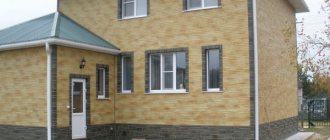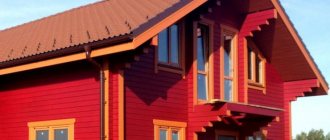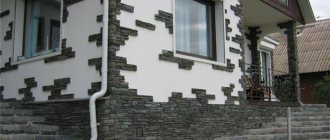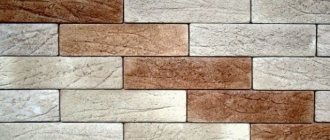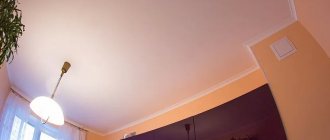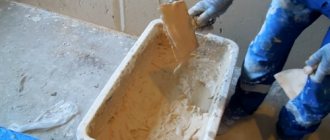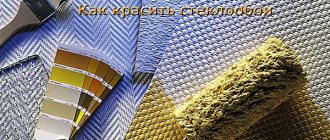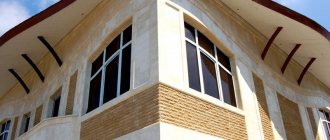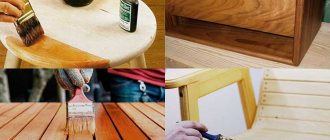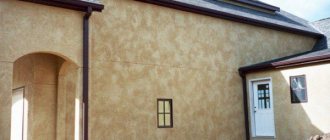The quality of the exterior decoration of a house is visually determined only by assessing the level of wall painting.
It doesn’t matter whether a complete layer-by-layer processing was carried out, the entire complex of work was done from scratch, or only cosmetic painting of the walls was done - outwardly everything looks exactly the same and for most it means the same thing - repairs have been made.
This is the main property of facade paint - the creation of a decorative outer layer that makes the appearance of the building new and elegant . Sometimes simply repainting the walls a different color looks like a complete change in the appearance of the house, affecting all elements of the architecture, although there were no structural additions or other interventions.
At the same time, painting the walls of a dacha touches on much more important operational issues, not limited to external effects. In this article we will talk about how to paint a private house with your own hands (+photo) and how to properly care for the surface.
Why do you need to paint the facade?
Painting the facade is the application of an external decorative and protective layer of the outer coating . In addition to purely visual changes, the paint layer creates a durable protective film that cuts off the wall material from the penetration of water from outside, from temperature influences, and eliminates the appearance of mold, mildew or algae.
In addition, an important ability of facade coatings is vapor permeability , i.e. the ability to remove moisture from the inside at the capillary level without the possibility of absorption from the outside.
Paints that do not have high vapor permeability are unsuitable for outdoor use, since steam, which does not have an outlet, begins to accumulate inside the walls, causing them to become wet, and ultimately the moisture freezes, expands and tears the walls from the inside.
Therefore, the correct choice of paint is a very important point; the durability of materials and structures, the possibility of proper operation of the wall pie, and only last but not least, the decorative qualities of the finish depend on it.
Types of facade paints
Facade paints have approximately the same structural composition:
- Base (film former).
- Fillers.
- Pigments.
- Solvent.
Based on the type of paint base there are:
- Mineral. The basis is derivatives of cement and lime, which are inexpensive materials.
- Silicate. They are produced on the basis of liquid glass with additives. They have low water-repellent ability.
- Silicone. Expensive paints based on silicone resins. They have an excellent set of properties - high vapor permeability, completely impervious to water, very elastic. The reason for its rare use is the high cost of the material.
- Acrylic. One of the most common paint groups, it has good qualities and a relatively low price.
By type of solvent:
- Aquatic.
- Using organic solvents (white spirit, etc.).
IMPORTANT!
The choice of one or another type of paint is determined by the wall material and operating characteristics, climatic and weather conditions of the region.
Painting the external walls of a wooden house
The methods used when painting the facades of wooden houses are approximately the same as when painting houses made of any other materials, but they have some differences.
Applying a protective layer to wooden walls
When painting wooden walls, several types of paints are used, opaque paints, coating and glazing antiseptics, translucent ones. Various acrylate and oil dyes are also used.
The paint, which contains an antiseptic, serves to protect the wood; it penetrates several millimeters deep into the surface of the wood. If the wood itself has a beautiful color, then it is better to use transparent paint with an antiseptic to cover it; it will highlight not only the color, but also the structure of the wood.
The translucent composition of such paint covers the color, but just like the transparent one it is able to highlight the structure of the wood.
Stages of work when painting a facade
The work is carried out in two stages - applying a primer containing an antiseptic and painting the wooden surface of the house. The primer serves to protect wooden walls from mold, excessive humidity and fungus formation. The second layer is applied acrylate or oil facade paint.
Helpful advice! It is better to apply a primer that contains an antiseptic (required!) in two or three layers, after each layer has dried.
The paint should be applied in exactly the same way, and before painting the house, you should try painting a separate board of the same type of wood to check the color.
Before starting painting work, it is necessary to mix the paint thoroughly; during the work, it should be stirred as often as possible. Painting wooden surfaces exposed to direct sunlight and during precipitation is unacceptable. The paint should be applied with longitudinal movements of the brush.
DIY facade painting
If a glossy film has formed on the wood, then it is worth painting it with a darker color of paint. Wood that was previously painted with oil paint can be coated with paint of a similar composition or acrylate dye, but before that, carefully remove the old paint to the wood using a wire brush.
The entire surface of the walls must be thoroughly washed, then carefully remove old paint, dust and resin using a stiff brush or scraper. Ideally, after all these procedures, it is better to degrease the walls with alkaline detergents and start painting only after the walls of the house have completely dried. You need to know that the quality of all the work done directly depends on the thoroughness of preparation for them.
It happens that to remove the old layer of paint you have to resort to mechanical and chemical methods. The chemical cleaning method better preserves the surface and structure of the wood, but is more labor-intensive and time-consuming than the mechanical method. This method is applicable only when it is not possible to clean the surface by other means.
The more thoroughly the old paint was removed, the smoother the new layer will lie and the more firmly it will adhere to the surface of the wooden wall.
Water based paints
Water-based (water-dispersed) paints are an emulsion of small particles of a working mixture in water . When applied, water is partially absorbed into the base, and partially evaporates, leaving a coating film that, after drying, does not react at all to the influence of water.
This composition has important advantages:
- No smell . This is the main advantage of water-based materials, which often determines the choice of users.
- No strong shine . The surface has either a deeply matte or soft silky sheen. Visually matte surfaces look smoother, do not glare and create a noble and stylish appearance of a house or cottage.
- Availability of excellent working qualities of the coating . Almost all water-dispersed paints have a full set of properties that allow them to successfully perform their functions.
- Possibility of tinting in any color . All water-based compositions are available in the form of two or three types - bases. Usually the first one is white and can be used as an independent paint or tinted in some light shade. The second and third are transparent, intended for tinting into denser and brighter colors.
- Low consumption . Most water-based formulations have high hiding power and low (relatively) density, which allows them to cover a larger area than other types of paints.
- Quick drying . Unlike other types, water mixtures dry within a few hours, allowing for maximum speed of work.
- Plain water is used as a diluent, which makes the work much easier (and cheaper) and helps keep the working tools in order and clean.
The disadvantages of water-based paints are:
- Contraindications for use on metal substrates.
- Weather restrictions, cannot be applied in rainy weather.
- The stains that appear are difficult to erase, and repeated washing of the walls spoils the appearance of the coating.
The disadvantages of water-dispersed facade paints are not critical; the popularity of such compositions is steadily growing.
Main types of paints used for exterior work
The most important requirements for facade paints for plaster are resistance to weather conditions and mechanical damage. In addition, unlike materials for interior work, hygroscopic compounds are needed here. Such paints do not accumulate condensation due to the difference in temperatures outside and inside the building.
Features, characteristics and consumption
Depending on the active component in the composition, the following types of paints are distinguished.
- Acrylic. The most popular because it is suitable for different surfaces: concrete, brick, plaster. It is based on resin, which makes the paint resistant to abrasion and moisture. You can add any color to the white base and get beautiful colors.
For well-prepared surfaces, water-based acrylic paint is suitable. It does not have a strong odor, is cheaper than analogues, and tolerates temperature changes well. Approximate consumption 0.5-0.7 l per 1 sq. m.
- Silicone. This is a polymer-based facade paint for plaster. The water-repellent properties of the polymer are inherent at the molecular level, so even with sudden temperature fluctuations, the paint will retain its protective characteristics.
Silicone compounds are suitable for all surfaces. They are very plastic, so they fill small cracks in the base well, which means you can skip the preliminary puttying step. This paint prevents the proliferation of microorganisms, so the walls do not need to be specially impregnated with antiseptic primer.
The only negative is that if you compare it with the cost of acrylic compositions, it will be twice as high. However, craftsmen believe that the quality and durability of the exterior finish will make up for this difference. Approximate consumption 0.1-0.15 l per 1 sq. m.
- Limestone. The slaked lime in the composition has high vapor permeability and protects well from the appearance of pathogenic microorganisms. But using lime paint for exterior plastering work is not a good option. Such compositions react very poorly to moisture, so the facades are repainted every year. Approximate consumption 0.1-0.16 liters per 1 square. m.
- Cement. It contains minerals and coloring pigments. It is more resistant to moisture than the previous option, but has absolutely no antiseptic properties. Therefore, they are almost never used now. Approximate consumption 0.1-0.16 liters per 1 square. m.
- Latex. Thanks to rubber particles in the composition, a durable coating is obtained. Only acrylic silicone options are suitable for facades. Approximate consumption 0.1-0.14 liters per 1 square. m.
Organic based paints
Organic-based materials are more traditional because they have been used for a long time. Many users prefer them precisely for this reason, not trusting the apparent fragility of water-based compositions.
Organic-based paints have many advantages:
- Durability of the coating.
- Elasticity, the ability to compensate for minor movements during shrinkage.
- Water resistance.
- Frost resistance.
- Vapor permeability.
- Compatible with most surfaces , excellent adhesion to metals.
- Tolerance of sudden temperature fluctuations.
- Durability.
- Possibility of painting at low temperatures or high humidity.
The disadvantages include:
- Pungent odor upon application and for some time after drying.
- Drying one layer requires a long time - two days; for subsequent layers, the drying time increases.
- The need to use solvents, which increases costs.
Organic solvent paints have a strong shine. This property causes different attitudes - for some it is very desirable, others consider it a disadvantage.
NOTE!
In addition, a significant disadvantage of organic solvent paints is the strong odor , which is very poorly tolerated and can cause poor health in some people.
This circumstance reduces the competitiveness of such paints compared to water-based paints, although the other qualities of the material are quite successful and make it possible to create a durable and durable coating.
Plastering technology
Plastering the facade can begin after the building has completely settled. It is also advisable to complete the roofing, waterproofing and electrical wiring before carrying out plastering work.
Before starting work, preparation is carried out - the working surface is cleaned of dirt, grease stains and other substances that may affect the adhesion of the plaster to the wall.
Note! When plastering during a dry, hot period, the facade wall must be moistened - otherwise adhesion may be insufficient.
Plastering a building using beacons
Classic instructions for plastering with cement plaster:
- Installation of beacons - metal profiles are attached to the entire height in increments of 1 m. First, the two outer beacons are attached, an index cord is stretched between them, along which the remaining guides are installed.
- Cape - the plaster solution is thrown onto the wall with a sharp slap using a trowel. This is how the space between the beacon is filled, the thickness of the layer should protrude slightly beyond the profile.
- Leveling - the rule is installed on the beacons from below, a sharp upward movement is carried out, without lifting the rule from the beacons.
- Repeated cape - after working with the rule, sinuses remain on the surface of the plaster - they are again clogged with mortar using a cape.
- Final alignment - the rule is again installed on the beacons, the alignment steps are repeated.
- Grouting - after the plaster has dried a little, grouting is carried out. The grater is tightly installed on the plaster, circular movements are performed without removing the tool from the surface.
Other types of plaster are applied to the initially primed surface of the facade. Using a large spatula, apply the first layer. After drying the layer, subsequent layers are applied, drying is performed after each layer.
Leveling is done with a spatula, grater or trowel.
Leveling plaster with a polisher
Note! On soft surfaces (mineral wool, polystyrene foam), the facade is reinforced with fiberglass mesh - otherwise the plaster will crack.
The number of layers depends on the complexity of leveling the surface. Minimum 2 layers applied.
How to choose façade paint for a specific surface?
- First of all, to correctly select the outer covering, you should take into account the base material . Most façade coatings specialize in concrete (including after wall insulation with foam plastic), brick, aerated concrete and plasters of various compositions. At the same time, water-based paints are not always suitable for wooden surfaces and are completely unsuitable for application to metal (steel) substrates, which is the main difference from paints based on organic solvents, which serve as reliable protection for such substrates.
- The second selection factor is surface quality . The presence of shine and the color of the walls directly depend on the composition of the paint used for exterior decoration. Water-based mixtures have lighter tones and a predominantly matte surface, while organic-based materials make it possible to obtain coatings with a hard shine in dense tones, and the choice of color and its tonality is much wider than that of water-based paints.
- At the same time, we must not forget about the operating conditions of the building - in areas with high levels of atmospheric pollution from various industrial or other substances, dust or the presence of large amounts of exhaust gases (industrial or close to large highways), paints with high water-repellent ability should be used , allowing you to safely endure periodic cleaning the walls. For regions with frequent rains, this choice is also relevant, since the penetration of rainwater into the wall material threatens their destruction.
How to paint the facade?
Water based paints
They are the most popular finishing coating option for facades. Their advantages include both excellent performance characteristics and decorative properties - they are characterized by vapor permeability, elasticity, and high hiding power. There is no unpleasant odor after application, which is also very important. Water-soluble compositions are most often presented in white, but adding a color pigment allows you to get any color. This is especially convenient if the home design has several tones of the same color - just purchase a white base composition and a set of pigments and then mix them in the required proportion. But there is also a serious disadvantage in this system - it is necessary to prepare the entire volume of paintwork for painting the facade at one time, since it is unlikely that it will be possible to manually prepare the mixture of the desired shade again. You will have to contact the store for this service.
Water-soluble paints are made on the basis of silicates, acrylic and silicone; mixed compositions are also possible:
- Acrylic - used for various types of surfaces, with the exception of lime and silicate materials. For them, this option on an acrylic organic basis is not suitable.
- Latex or rubber paint - it is made water-based from acrylic polymers and latex, and is distinguished by rich shades. Such paints demonstrate resistance to moisture. They are good for surfaces made of wood, drywall, brick, concrete, plaster, even metal. The surface can even be covered with an old layer of any other paintwork. Rubber paints are economical and coverable, and tolerate UV rays, temperature changes and other natural influences well.
- Acrylic-silicone – they boast the advantages of silicone and acrylic compounds; they are used to cover concrete, cinder block brick walls, and facades made of mineral plaster. They are attractive due to their water-repellent qualities, resistance to weather and biological influences. They are vapor permeable, environmentally friendly, and therefore are an excellent choice for facades
- Silicate - such compositions based on potassium liquid glass are used for stone, concrete, plastered facades. Such coatings are durable, resistant to UV rays and temperature changes. An additional advantage of this paintwork is that there is no need to prime the surface or remove silicate paint. It is worth keeping in mind that such a surface can only be renewed using silicate paintwork. Other compositions do not apply on top of such a paint coating. Another disadvantage is the high cost of such materials.
- Silicone - is distinguished by water-repellent properties and vapor permeability, resists external influences, does not wash out, and all contaminants from it are easily washed off with rainwater. This paint coating effectively protects walls from mold, and due to its high elasticity, internal stress does not arise in it. However, along with the performance characteristics, there is also a serious drawback - the high price.
- Polyvinyl acetate paints are characterized by low color fastness - the paint fades in 1-2 years due to the aggressive environment. But as a temporary option, it is ideal because it is low in cost. Before painting the wall, be sure to cover the walls with silicate plaster and prime it.
- Lime compositions - used for painting plastered surfaces. Due to the presence of antiseptics in the composition, the paint resists the spread of fungal diseases.
- Cement - when sold, it is a powder with additives and dye, which must be brought to condition by adding water.
Organic based paintwork
- Oil based – made on the basis of drying oil with a finely ground coloring mineral dye. That is why, before painting, you should first stir the contents of the bucket to return it to a uniform structure. Such paints can cover any surface, the main thing is to prepare it and cover it with a layer of primer. Modern oil-based paint and varnish coatings differ significantly from outdated compositions, and therefore have excellent technical characteristics - good adhesion, resistance to temperature changes and humidity. But the disadvantages include rapid fading. So it is better to choose light colors - in this case, even a faded shade looks attractive.
- Alkyd - they are based on alkyd varnishes with coloring pigments and a solvent. When purchasing, pay attention to the scope of application, which is indicated directly on the can - choose enamel for external work or a universal option. Alkyd enamel is elastic, durable, and resistant to temperature changes, but its resistance to UV radiation is not the best.
TOP manufacturers of facade paints
Among the popular manufacturers of paint and varnish products there are both foreign companies and companies from the Russian Federation that produce facade paintwork. Among the Russian companies we can note Senezh, Olekolor, Yaroslavl paints, Rogneda, Drevoplast, Neomid.
Of the foreign brands that have become widespread in the Russian Federation, the most popular are the German Alpina, the Greek Isomat, the Finnish Tikkurila, the Swedish Beckers and the English Dulux. All of these companies belong to the proven category, so their paint and varnish products are of guaranteed high quality. Such companies value their good reputation, so the characteristics of the compositions for painting building facades declared by the manufacturer fully correspond to the real state of affairs.
Painting the facade is a feasible task for all owners of private houses
Which façade paint is most optimal?
The optimally selected material must best comply with all existing conditions - operational, climatic. In addition, the decorative qualities of the coating are important, since they are primarily assessed when looking at a freshly painted house.
Recently, user preferences are increasingly given to water-dispersed compositions , which is understandable by their properties. The most important of these is the absence of odor.
The ability to remove paint stains with plain water is also important - an important plus, since solvents can also remove the necessary substances, which will lead to damage to objects accidentally stained with paint.
Preparing the wall surface for painting
For painting you will need a clean, dry wall surface.
To prepare you will need:
- Disconnect all hanging structures - brackets, awnings, lights, air conditioners, etc.
- Remove trim from windows or doorways.
- Inspect the walls, determine the degree of wear of plaster or other materials.
- Detected defects are puttied; in case of large quantities of peeling or shedding, it is recommended to apply a leveling plaster layer.
- Some types of facade paints require preliminary priming.
CAREFULLY!
Freshly applied cement or lime plaster must be allowed to sit for 4 weeks (minimum) before painting to complete crystallization of the layer and complete chemical processes within the plaster.
Tips for choosing colors
Facade plaster paints for exterior use are available in a wide range of colors, but choosing a color that matches the roof is not always easy. The optimal solution is pastel colors. If you don’t like monotony, you can dilute the main color with bright accents on window and door openings, railings and steps, and the chimney. Or paint it in 2 shades, but with paint of the same relief structure. An excellent option is a dark roof and light walls, or vice versa.
Color selection
Facade painting technology
Painting work is carried out in dry, windless weather.
The air temperature should be:
- For water-based paints - from +5° to +30°.
- For compositions based on organic solvents, the temperature range expands to the lower side (there are brands of paints that allow use down to -20°), but due to the strong odor, use in hot weather is difficult.
Paint is applied either mechanically - spray gun, air or airless spray, or manually using a roller or brushes.
IMPORTANT!
Before applying paint, be sure to carefully read the application method and additional working conditions in order to avoid possible mistakes.
Depending on the type of paint, the surface must be covered entirely at one time (mainly, such conditions apply to water-based coatings, since the junctions of different layers are very noticeable), or interruptions in work are possible (paints based on organic solvents).
Most often, the surface is painted in two layers, the interval between applying the second layer of paint is usually 16-24 hours.
Tools needed
In order to paint the facade with high quality, the following equipment is needed:
- brushes of different sizes or rollers;
- paint trough;
- spray gun;
- primer;
- film, with which you need to protect areas that are not subject to painting;
- stepladder or scaffolding;
- Protective clothing and goggles are advisable.
Brushes are suitable for painting small details or making a rosary and a beautiful outline. Large-scale painting of the facade of a house with your own hands is faster and better done using a roller or spray gun.
Clothing and glasses will protect against contact of coloring solutions with the skin or mucous membranes. You need to cover well with film those places where you don’t need to paint. During the process, material may run off or drip from the tool.
Tips for caring for painted surfaces
Maintenance of façade coverings is minimal. No action is required other than occasional hosing to remove dust.
The application of any protective compounds or other actions aimed at improving the condition of the coating is not used, since the quality and properties of the coating fully meet all requirements and do not require additional measures.
Facade paints, with all the breadth of assortment and variety of types, perform the same task. Since they are created precisely for this purpose, the difference in properties is not critical and consists only of some positions.
Water-based paints and materials based on organic solvents are able to fully satisfy all requests and provide high-quality protection of walls from external destructive factors, as well as decorate the house and create a stylish and neat appearance.
Preparatory stage
Regardless of what material the load-bearing ones are made of, for high-quality coating with façade paint, the base must be well prepared.
- You need to delete the old layer, if there was one.
- All dirt, grease stains, traces of mold or fungi must be removed.
- All holes and cracks are carefully sealed.
- Irregularities are sanded down.
- The prepared surface is coated with a deep penetration primer.
Only after the primer has completely dried can you begin to apply facade paint to the walls of the house.
